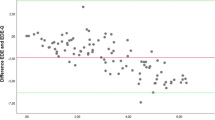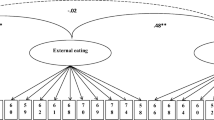Abstract
Clinical interviews are considered the gold standard for the evaluation of the specific psychopathology associated with eating disorders. However, there are situations in which brief but valid and reliable self-report questionnaires can be helpful. For this reason, we have developed a new questionnaire, called the DEQ (Disordered Eating Questionnaire), brief enough to be used in epidemiological screenings, that evaluates the frequency and intensity of disordered eating attitudes and behaviours within a time frame of three months and addresses face valid questions to the general population. The aim of this study was to evaluate the dimensionality, reliability and convergent validity of this questionnaire. The DEQ was filled in by Italian secondary school girls and boys, together with the Contour Drawing Rating Scale (CDRS) and with the Eating Attitudes Test (EAT-26). The results showed a single component that explain a portion of variance of around 36%. The reliability of the scale is highly satisfactory. The scale is also valid, since scores on the DEQ scale are significantly and highly correlated with body dissatisfaction, measured by the CDRS, with body mass inex (BMI) and with all the subscales of the EAT-26. As expected, there were gender differences, given that DEQ scores were higher in females than in males.
Similar content being viewed by others
References
Gordon R.A.: Eating Disorders. Anatomy of a Social Epidemic, 2nd ed, New York, Basel, Blackwell, 2000.
Cooper Z., Fairburn C.G.: The Eating Disorder Examination: A semi-structured interview for the assessment of the specific psychopathology of eating disorders. Int. J. Eat. Disord., 6, 1–8, 1987.
Garner D.M.: Eating Disorder Inventory-2: Professional Manual. Odessa, FL, Psychological Assessment Resources, 1991.
Garner D.M., Garfinkel P.E.: The Eating Attitudes Test: an index of the symptoms of anorexia nervosa. Psychol. Med., 9, 273–279, 1979.
Garner D.M., Olmstead M.P., Bohr Y.E., Garfinkel P.E.: The Eating Attitude Test: psychometric features and clinical correlates. Psychol. Med., 12, 871–878, 1982.
Stunkard A.J., Messick S.: The three-factor eating questionnaire to measure dietary restraint, disinhibition and hunger. J. Psychosom. Med., 29, 71–83, 1985.
Herman C.P., Polivy J.: Anxiety, restraint and eating behaviour. J Abnorm. Psychol., 84, 666–672, 1975.
Smith M.C., Thelen M.H.: Development and validation of a test for bulimia. J. Consult. Clin. Psychol., 52, 863–872, 1984.
Henderson M., Freeman C.P.L.: A self-rating scale for bulimia: The “BITE”. Br. J. Psychiatry, 159, 18–24, 1987.
Wilson G.T.: Assessment of binge eating. In: Fairburn C.G., e Wilson G.T. (Eds.), Binge eating: Nature, assessment and treatment. New York, Guilford Press, 1993, pp. 227–249.
Carter J.C., Stewart D.A., Fairburn C.G.: Eating Disorder Examination Questionnaire: Norms for young adolescent girls. Behav. Res. Ther., 39, 625–632, 2001.
Striegel-Moore R.: Risk factors for eating disorders. Ann. N.Y. Acad. Sci., 817, 98–109, 1997.
Nielsen S.: The Epidemiology of anorexia nervosa in Denmark from 1973 to 1987: A nationwide register study of psychiatric admission. Acta Psychol. Scand., 81, 507–514, 1990.
Lucas A.R., Beard M., O’Fallon W.M., Kurland L.T.: 50-year trends in the incidence of anorexia nervosa in Rochester, Minnesota: a population-based study. Am. J. Psychiatry, 148, 917–922, 1991.
Garner D.M., Garfinkel P.E.: Socio-cultural factors in the development of anorexia nervosa. Psychol. Med., 9, 647–656, 1980.
Petrie T.A.: Disordered eating in female collegiate gymnasts: Prevalence and personality attitudinal correlates. J. Sports Exerc. Psychol., 15, 424–436, 1993.
Mc Nulty P.A.: Prevalence and contributing factors of eating disorder behaviours in a population of Navy nurses. Milit. Med., 162, 703–706, 1997.
Garfinkel P.E., Newman A.: The Eating Attitudes Test: Twenty-five years later. Eating Weight Disord., 6, 1–24, 2000.
Fairburn C.G., Cooper Z.: The Eating Disorder Examination. In: Fairburn C.G., Wilson G.T. (Eds.), Binge eating: nature, assessment and treatment, 12th ed. New York, Guilford Press, 1993, pp. 317–360.
Fairburn C.G., Beglin S.J.: Assessment of eating disorders: Interview or self-report questionnaire? Int. J. Eat. Disord., 16, 363–370, 1994.
Luce K.H., Crowther J.H.: The reliability of the Eating Disorder Examination — Self-Report Questionnaire (EDE-Q). Int. J. Eat. Disord., 25, 349–351, 1999.
Thompson M.A., Gray J.J.: Development and validation of a new Body-Image Assessment Scale. J. Person. Assess., 64, 258–269, 1995.
Dotti A., Lazzari R.: Validation and reliability of the Italian EAT-26. Eat. Weight Disord., 3, 188–194, 1998.
Everett J.E., Entrekin L.V.: Factor comparability and the advantages of multiple group factor analysis. Multivar. Behav. Res., 15, 165–180, 1980.
Nunnally J.C.: Psychometric theory, 2nd ed. New York, McGraw-Hill, 1978.
Edwards A.L.: Experimental design in Psychological Research. New York, Holt, Rinehart and Winston, 1963.
Croll J., Neumark-Sztainer D., Story M., Ireland M.: Prevalence and risk and protective factors related to disordered eating behaviors among adolescents: relationship to gender and ethnicity. J. Adolesc. Health, 31, 166–175, 2002.
French S.A., Leffert N., Story M., Neumark-Sztainer D., Hannan P., Benson P.L.: Adolescent binge/purge and weight loss behaviors: associations with developmental assets. J. Adolesc. Health, 28, 211–221, 2001.
Author information
Authors and Affiliations
Corresponding author
Rights and permissions
About this article
Cite this article
Lombardo, C., Russo, P.M., Lucidi, F. et al. Internal consistency, convergent validity and reliability of a brief Questionnaire on Disordered Eating (DEQ). Eat Weight Disord 9, 91–98 (2004). https://doi.org/10.1007/BF03325051
Published:
Issue Date:
DOI: https://doi.org/10.1007/BF03325051




